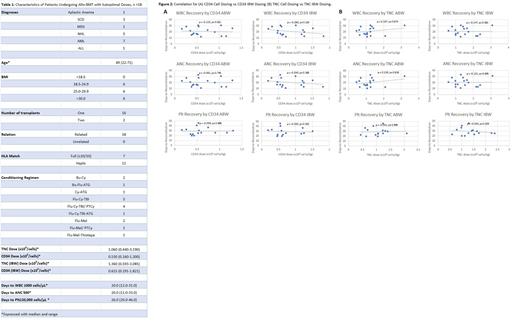Abstract
Background: Allogeneic stem cell transplant (allo-SCT) is the only curative treatment for many hematologic malignancies. Stem cells can be collected from bone marrow, peripheral blood, or cord blood. Peripheral blood is the most common utilized source due to its convenience and the ability to collect high numbers of stem cells, but studies suggest that bone marrow offers certain advantages over peripheral blood, especially lower rates of graft-vs-host disease (Holtick et. al. Cochrane 2014), leading to higher survival in patients with nonmalignant disorders .
The ideal cell dose for SCT is 2 x 106 cells/kg CD34 cells. However, in cases of bone marrow graft, if a suboptimal cell dose is collected, it is often not feasible to repeat extraction. This is especially difficult for minority ethnic groups who already face systemic barriers to care. Our goal for this study was to assess the correlation of CD34 dose to hematopoietic recovery in a minority-rich population of fresh marrow allogeneic stem cell recipients.
Prior studies have also suggested that the cell dosing for transplant should be calculated by ideal body weight (IBW) rather than the standard actual body weight (ABW) (Cilley et. al. Bone Marrow Transplantation 2004). We assessed the correlation of recovery for ABW vs IBW as well.
Methods: From 2012-2022, eighteen patients were identified in the Montefiore health system who received a bone marrow graft for allo-SCT with suboptimal CD34 doses. Alongside CD34 dose, an additional predictor evaluated was total nucleated cell (TNC) dose. ABW-based and IBW-based doses were calculated for both CD34 and TNC doses. Several outcomes were tracked for the eighteen patients, including "Days to WBC 1000 cells/μL", "Days to ANC 500 cells/μL ", and "Days to Plt≥20,000 cells/μL." The relationship between cell doses (ABW and IBW-based) and outcomes were evaluated independently through calculation of Spearman's correlation. Analysis and modeling were performed in RStudio 4.1.2.
Results:
AML and NHL patients made up the largest proportion of the sample (7/18 and 5/18) (Table 1). The median ABW-based CD34 dose (0.530 x 106 CD34 cells/kg) was nearly four times smaller than the standard of 2 x 106 cells/kg CD34 cells. Fifteen of 18 patients achieved reconstitution goals. Of the three patients who did not, one had persistent disease at the time of transplant and developed multiorgan failure dying within 17 days prior to hematopoietic recovery. Another died at day 58 without any platelet recovery. A third maintained platelets above 20,000 cells/μL throughout transplant.
Assessing ABW-based CD34 dosing and IBW-based CD34 dosing as independent predictors, none of the outcomes, were significantly correlated (P > 0.05) (Figure 2). However, the Spearman's correlation coefficients were consistently of larger magnitude for IBW-based CD34 dosing than for ABW-based CD34 dosing for all three outcomes. Assessing ABW-based TNC dosing and IBW-based TNC dosing as independent predictors yielded no significant correlation.
Conclusion: Studies suggest that there are benefits to bone marrow grafts over that of peripheral stem cell grafts. However, bone marrow harvesting is a process that is not easily repeated in cases where doses are inadequate, especially if the recipient has already undergone conditioning. We reviewed 18 cases of allo-SCTs performed at a single center with suboptimal CD34+ doses. In most cases, hematopoietic reconstitution was achieved. In our cohort of patients with suboptimal CD34+ doses in allo-BM SCTs, we noted no significant correlation between the dosages and outcomes for hematopoietic reconstitution. These results suggest there may be utility in taking a more liberal approach to standards for bone marrow graft doses, but this requires further study, and a much larger sample size. Additionally, we looked at CD34 dosing based on ABW versus IBW and noted consistent increases in magnitude for the Spearman Correlation's. Given the small sample evaluated, it is worth looking at this further with larger samples to see if dosing for bone marrow harvest by IBW may be more correlated with hematopoietic reconstitution in allogeneic SCT than dosing by ABW.
Disclosures
Shastri:Janssen: Consultancy; Rigel Pharmaceutical: Membership on an entity's Board of Directors or advisory committees; NACE: Honoraria; Kymera Therapeutics: Membership on an entity's Board of Directors or advisory committees, Research Funding. Verma:Jannsen: Consultancy, Research Funding; Medpacto: Research Funding; Eli Lilly: Research Funding; Stelexis Therapeutics: Current equity holder in private company, Honoraria; Prelude: Research Funding; Novartis: Consultancy; BMS: Research Funding; Throws Exception: Current holder of stock options in a privately-held company; Ionctura: Research Funding; Bakx Therapeutics: Consultancy, Current equity holder in private company; Curis: Consultancy, Research Funding.
Author notes
Asterisk with author names denotes non-ASH members.


This feature is available to Subscribers Only
Sign In or Create an Account Close Modal